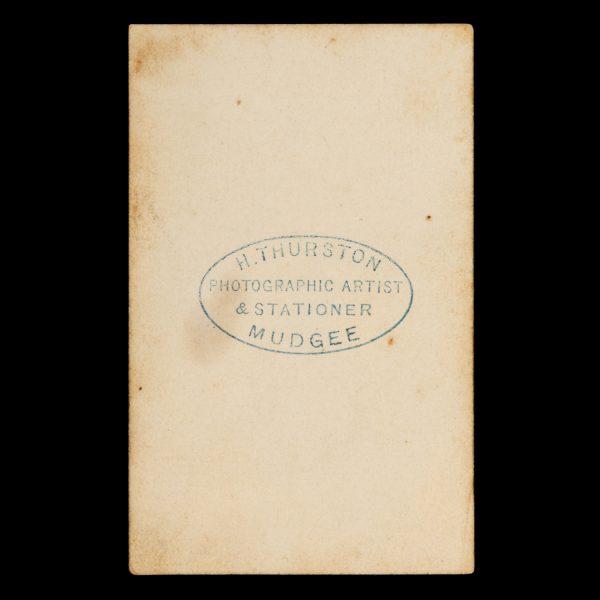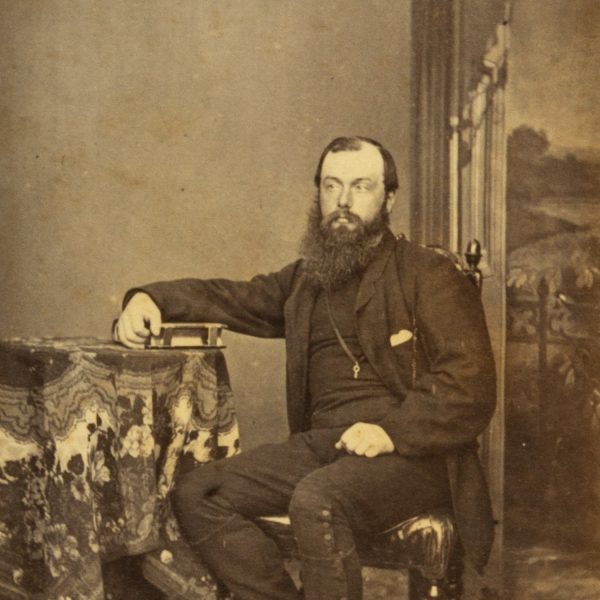# 40401
THURSTON, Horatio (1838-1881)
Gentleman seated at a table, holding a photograph album. Mudgee, New South Wales, 1867-68.
$400.00 AUD
Albumen print photograph, carte de visite format, 101 x 63 mm (mount), verso with wet stamp of ‘H. Thurston, Photographic Artist & Stationer, Mudgee’; both the print and mount are in excellent condition.
An extremely rare example of a carte de visite studio portrait from Horatio Thurston’s brief career as a professional photographer in Mudgee, in the Central West New South Wales. Trove locates no examples of Thurston’s photographs in Australian collections.
From an album belonging to the Evans family of Bombandy, between Cudgegong and Rylstone, southeast of Mudgee in the Central West of New South Wales.
From DAAO:
‘Horatio Thurston, sketcher, professional photographer, calligrapher, tutor, clerk, storekeeper and miner, was born in Hampshire, England on 22 March 1838, second son of John Noel Thurston and his wife, Eliza. He reached Sydney on 4 September 1853 as a passenger in the barque Ann Holzber , his older brother John Bates Thurston (later Sir John, Governor of Fiji 1887-97) being a member of the crew. Horatio’s mother and three sisters joined him in Sydney on 23 December 1853. Horatio worked for a time on the New South Wales goldfields at Hanging Rock and Peel River diggings, in a merchant’s office at Sydney and as a storekeeper in Newcastle. Early in 1856 he moved to Mudgee as a storekeeper, briefly became tutor to the children of George Tailby, a squatter of Fernside, Rylstone, then was employed as an attorney’s clerk in Mudgee. On 9 June 1863 he married Tailby’s daughter Jane; they had ten children.
In 1867/1868 Horatio Thurston set up as a professional photographer and stationer in Mudgee. A studio portrait of his sister Emily survives from this period (p.c.). His brother John had taken lessons in photography at Sydney in 1864 before searching for botanical specimens in the Pacific Islands and Horatio possibly learned his trade at the same time. For a while John Thurston sold photographs in the Pacific Islands for a living, but Horatio’s Mudgee studio does not seem to have been as profitable. In 1870-71 he was town clerk at Mudgee, but he had reverted to being an attorney’s clerk by December 1871 when he gave this as his occupation on the birth certificate of his sixth and fourth surviving child (a 9-month-old son had died the previous January from inhaling a prairie-grass seed).
Later Horatio Thurston was appointed secretary and librarian of the Mudgee Mechanics Institute and appears to have made quite a success of these positions. It was reported that the Institute’s (School of Arts’) exhibit at the Mudgee Agricultural Show in March 1879 included ‘a court of fine arts, &c., embracing some choice pictures and miniatures, penmanship, minerals, sericulture, conchology, and taxidermy, the work principally of H. Thurston, custodian of the School of Arts (who not only merited his prizes for the worth of his exhibits, his own work, but also praise for his efforts to make the School of Arts Exhibition all that it should be)’. He died at Mudgee on 6 July 1881 after a fall from a horse.’








